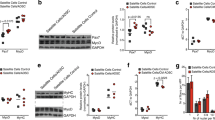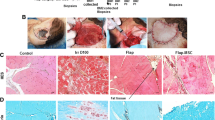Abstract
Background:
Skeletal muscle injuries are frequent clinical challenges due to associated fibrosis and disability. Regenerative medicine is an emerging promising strategy for such cases. The aim of this study was to compare between the effects of bone marrow-mesenchymal stem cells (BM-MSCs) versus adipose tissue stromal cells (ADSCs) on regeneration and re-innervation of skeletal muscle laceration injury in Wistar rats at different time intervals.
Methods:
Six young male rats were used as a source of allogenic MSCs. Eighty-four adult female rats were divided into: Group I (control), Group II (Untreated Laceration): right gluteal muscle was lacerated and left for spontaneous healing, Group III (BM-MSCs): right gluteal muscle was lacerated with concomitant local intramuscular injection of 1 × 106 BM-MSCs in the lacerated muscle, Group IV (ADSCs): right gluteal muscle was lacerated with concomitant local intramuscular injection of 1 × 106 ADSCs in lacerated muscle. Rats were sacrificed after one, two and eight weeks. Muscles were processed to prepare sections stained with H&E, Mallory’s trichrome and immune-histochemical staining (neurofilament light chain).
Results:
A significant increase in collagen fibers and failure of re-innervation were noticed in untreated laceration group. BM-MSCs-treated groups showed regeneration of muscle fibers but with increased collagen fibers. Meanwhile, ADSCs showed better regenerative effects evidenced by significant increase in the number of myotubes and significant decrease in collagen deposition. Re-innervation was noticed in MSCs-injected muscles after 8 weeks of laceration.
Conclusion:
Both BM-MSCs and ADSCs improved regeneration of skeletal muscle laceration injury at short- and long-term durations. However, fibrosis was less in ADSCs-treated rats. Effective re-innervation of injured muscles occurred only at the long-term duration.










Similar content being viewed by others
References
Beldjilali-Labro M, Garcia A, Farhat F, Bedoui F, Grosset J, Dufresne M, Legallais C. Biomaterials in tendon and skeletal muscle tissue engineering: current trends and challenges. Materials (Basel). 2018;11:1116.
Pereira T, Gärtner A, Amorim I, Armada-da-Silva P, Gomes R, Pereira C, et al. Biomaterials and stem cell therapies for injuries associated to skeletal muscle tissues. Adv Biomater Sci Biomed Appl. 2013;23:329–63.
Peçanha R, Bagno LL, Ribeiro MB, Robottom Ferreira AB, Moraes MO, Zapata-Sudo G, et al. Adipose-derived stem-cell treatment of skeletal muscle injury. J Bone Joint Surg Am. 2012;94:609–17.
Tian ZL, Jiang SK, Zhang M, Wang M, Li JY, Zhao R, et al. a7nAChR is expressed in satellite cells at different myogenic status during skeletal muscle wound healing in rats. J Mol Histol. 2015;46:499–509.
Filareto A, Rinaldi F, Arpke RW, Darabi R, Belanto JJ, Toso EA, et al. Pax3-induced expansion enables the genetic correction of dystrophic satellite cells. Skelet Muscle. 2015;5:36.
Moloney EB, de Winter F, Verhaagen J. ALS as a distal axonopathy: molecular mechanisms affecting neuromuscular junction stability in the presymptomatic stages of the disease. Front Neurosci. 2014;8:252.
Laumonier T, Menetrey J. Muscle injuries and strategies for improving their repair. J Exp Orthop. 2016;3:15.
Feisst V, Meidinger S, Locke MB. From bench to bedside: use of human adipose-derived stem cells. Stem Cells Cloning. 2015;8:149–62.
McFarlin K, Gao X, Liu YB, Dulchavsky DS, Kwon D, Arbab AS, et al. Bone marrow-derived mesenchymal stromal cells accelerate wound healing in the rat. Wound Repair Regen. 2006;14:471–8.
Cakici C, Buyrukcu B, Duruksu G, Haliloglu A, Aksoy A, Isik A, et al. Recovery of fertility in azoospermia rats after injection of adipose-tissue derived mesenchymal stem cells: the sperm generation. Biomed Res Int. 2013;2013:529589.
Li H, Fu X, Ouyang Y, Cai C, Wang J, Sun T. Adult bone marrow-derived mesenchymal stem cells contribute to wound healing of skin appendages. Cell Tissue Res. 2006;326:725–36.
Karaoz E, Aksoy A, Ayhan S, Sariboyaci AE, Kaymaz F, Kasap M. Characterization of mesenchymal stem cells from rat bone marrow: ultrastructural properties, differentiation potential and immunophenotypic markers. Histochem Cell Biol. 2009;132:533–46.
Suvarna K, Layton C, Bancroft J. Theory and practice of histological Techniques. 7th ed. London: Churchill Livingston; 2013.
Petrosyan K, Tamayo R, Joseph D. Sensitivity of a novel Biotin- free Detection Reagent (powervision+™) for immune histochemistry. J Histotechnol. 2002;25:247–50.
Liu J, Saul D, Böker KO, Ernst J, Lehman W, Schilling AF. Current methods for skeletal muscle tissue repair and regeneration. Biomed Res Int. 2018;2018:1984879.
Li CY, Wu XY, Tong JB, Yang XX, Zhao JL, Zheng GF, et al. Comparative analysis of human mesenchymal stem cells from bone marrow and adipose tissue under xeno-free conditions for cell therapy. Stem Cell Res Ther. 2015;6:55.
Baer PC, Geiger H. Adipose-derived mesenchymal stromal/stem cells: tissue localization, characterization, and heterogeneity. Stem Cells Int. 2012;2012:812693.
Kharraz Y, Guerra J, Mann CJ, Serrano AL, Muñoz-Cánoves P. Macrophage plasticity and the role of inflammation in skeletal muscle repair. Mediators Inflamm. 2013;2013:491497.
Quintero AJ, Wright VJ, Fu FH, Huard J. Stem cells for the treatment of skeletal muscle injury. Clin Sports Med. 2009;28:1–11.
Montarras D, L'honoré A, Buckingham M. Lying low but ready for action: the quiescent muscle satellite cell. FEBS J. 2013;280:4036–50.
Joe AW, Yi L, Natarajan A, Le Grand F, So L, Wang J, et al. Muscle injury activates resident fibro/adipogenic progenitors that facilitate myogenesis. Nat Cell Biol. 2010;12:153–63.
Yin H, Price F, Rudnicki MA. Satellite cells and the muscle stem cell niche. Physiol Rev. 2013;93:23–67.
Shi X, Garry DJ. Muscle stem cells in development, regeneration, and disease. Genes Dev. 2006;20:1692–708.
Kholodenko IV, Konieva KAA, Kholodenko RV, Yarygin KN. Molecular mechanism of migration and homing of intravenously transplanted mesenchymal stem cells. J Regen Med Tissue Eng. 2013;1:1–4.
Andrade BM, Baldanza MR, Ribeiro KC, Porto A, Peçanha R, Fortes FS, et al. Bone marrow mesenchymal cells improve muscle function in a skeletal muscle re-injury model. PLoS One. 2015;10:e0127561.
Shabbir A, Zisa D, Leiker M, Johnston C, Lin H, Lee T. Muscular dystrophy therapy by nonautologous mesenchymal stem cells: muscle regeneration without immunosuppression and inflammation. Transplantation. 2009;87:1275–82.
Dumont NA, Wang YX, von Maltzahn J, Pasut A, Bentzinger CF, Brun CE, et al. Dystrophin expression in muscle stem cells regulates their polarity and asymmetric division. Nat Med. 2015;21:1455–63.
Nagaya R, Mizuno-Kamiya M, Takayama E, Kawaki H, Onoe I, Tanabe T, et al. Mechanisms of the immunosuppressive effects of mouse adipose tissue derived mesenchymal stromal cells on mouse alloreactively stimulated spleen cells. Exp Ther Med. 2014;7:17–22.
Gonzalez-Rey E, Gonzalez MA, Varela N, O’Valle F, Hernandez-Cortes P, Rico L, et al. Human adipose-derived mesenchymal stem cells reduce inflammatory and T cell responses and induce regulatory T cells in vitro in rheumatoid arthritis. Ann Rheum Dis. 2010;69:241–8.
Karalaki M, Fill S, Philppou A, Koutsilieris M. Muscle regeneration: cellular and molecular events. In Vivo. 2009;23:779–96.
Kowalski K, Dos Santos M, Maire P, Ciemerych MA, Brzoska E. Induction of bone marrow-derived cells myogenic identity by their interactions with the satellite cell niche. Stem Cell Res Therapy. 2018;9:258.
Cui L, Yin S, Liu W, Li N, Zhang W, Cao Y. Expanded adipose-derived stem cells suppress mixed lymphocyte reaction by secretion of prostaglandin E2. Tissue Eng. 2007;13:1185–95.
Forcales SV. Potential of adipose-derived stem cells in muscular regenerative therapies. Front Aging Neurosci. 2015;7:123.
Desmoulière A, Darby IA, Gabbiani G. Normal and pathologic soft tissue remodeling: role of the myofibroblast, with special emphasis on liver and kidney fibrosis. Lab Invest. 2003;83:1689–707.
Wynn TA. Cellular and molecular mechanisms of fibrosis. J Pathol. 2008;214:199–210.
Liu X, Zheng L, Zhou Y, Chen Y, Chen P, Xiao W. BMSC transplantation aggravates inflammation oxidative stress and fibrosis and impairs skeletal muscle regeneration. Front Physiol. 2019;10:87.
Kang SB, Olson JL, Atala A, Yoo JJ. Functional recovery of completely denervated muscle: implications for innervation of tissue-engineered muscle. Tissue Eng Part A. 2012;18:1912–20.
Xiong CJ, Li PF, Song YL, Xue LX, Jia ZQ, Yao CX, et al. Insulin induces C2C12 cell proliferation and apoptosis through regulation of cyclin D1 and BAD expression. J Cell Biochem. 2013;114:2708–17.
Fairbairn NG, Meppelink AM, Ng-Glazier J, Randolph MA, Winograd JM. Augmenting peripheral nerve regeneration using stem cells: a review of current opinion. World J Stem Cells. 2015;7:11–26.
Delk NA, Farach-Carson MC. Interleukin-6: a bone marrow stromal cell paracrine signal that induces neuroendocrine differentiation and modulates autophagy in bone metastatic PCa cells. Autophagy. 2012;8:650–63.
Tse KH, Novikov LN, Wiberg M, Kingham PJ. Intrinsic mechanisms underlying the neurotrophic activity of adipose derived stem cells. Exp Cell Res. 2015;331:142–51.
Marconi S, Castiglione G, Turano E, Bissolotti G, Angiari S, Farinazzo A, et al. Human adipose-derived mesenchymal stem cells systemically injected promote peripheral nerve regeneration in the mouse model of sciatic crush. Tissue Eng Part A. 2012;18:1264–72.
Author information
Authors and Affiliations
Corresponding author
Ethics declarations
Conflicts of interest
The authors have no conflicting financial or competing interests.
Ethical statement
The animal experiment was conducted in the Research Center institute (MASRI), Faculty of Medicine, Ain Shams University. The FMASU REC is organized and operated according to guidelines of the International Council on Harmonization (ICH) and the Islamic Organization for Medical Science (IOMS), the United States Office for Human Research Protections and the United States Code of Federal regulations and operates under Federal Wide Assurance N. FWA 00017585.
Additional information
Publisher's Note
Springer Nature remains neutral with regard to jurisdictional claims in published maps and institutional affiliations.
Rights and permissions
About this article
Cite this article
Moussa, M.H., Hamam, G.G., Abd Elaziz, A.E. et al. Comparative Study on Bone Marrow-Versus Adipose-Derived Stem Cells on Regeneration and Re-Innervation of Skeletal Muscle Injury in Wistar Rats. Tissue Eng Regen Med 17, 887–900 (2020). https://doi.org/10.1007/s13770-020-00288-y
Received:
Revised:
Accepted:
Published:
Issue Date:
DOI: https://doi.org/10.1007/s13770-020-00288-y




